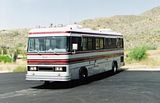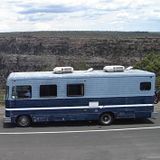Go to...  | Start A New Topic  | Search  | Notify  | Tools  | Reply To This Topic  |  |
Hello, it appears that our alternator is shot. I have removed it and it is only a 55A alternator. Is this typical? Seems like most are larger. For instance NAPA shows this 55A as well as an 80A for the Chevy P30 Chassis (454 engine)that we have. Can we just switch to the 80A? Or should we replace with the 55A version that we are removing? | |||
|
 3/11 3/11 |
So long as it fits (mounting tabs and bolt pattern) and your pulley will fit (probably will) and the measurement from the center of the pulley to the mount bolts keeps the belt straight and true you can buy as big as you want. A 105 amp should be very close for not much more money. 1993 32' Regency Wide Body, 4 speed Allison Trans, Front Entry door, Diamond Plate aluminum roof & 1981 Euro 22' w Chevy 350 engine and TH 400 tranny | |||
|
| 1st month member |
It depends on the load that is placed on the electrical system. I would go for the 80 amp or bigger to power up the clearance lights, horn air pump, air bag pump, etc. Mine came stock with a 180 amp PowerMaster alternator. 1999 Airstream Safari 25' 2007 Toyota Tundra 1987 Yamaha YSR toads | |||
|
I was just surprised that it had an alternator that was only 55amps. Doesn't that seem extremely low? | ||||
|
 12/10 12/10 |
NBO, It probably came off of that old Chevy in his yard that he hadn't driven in years.... But it might be wise at this point to see what size it came with as that is what determined the wire size, and protection, that it is connected to... | |||
|
How would I find out what alternator came with this unit originally? | ||||
|
"Host" of Barthmobile.com 1/19 1/19 |
Put on the 80 amp alt.
| |||||||||||||||
| ||||||||||||||||
| First Month Member |
My rec is to buy one from a local dealer with a lifetime warranty. With the cheap labor and cheap parts being used nowadays, you will need a warranty and a handy dealer. You should buy a common number, so that it can be replaced easily. Best is to tell them that you have a pickup with a 454 and air conditioning. That will get you a very commonly stocked alternator. Warranty replacement will be convenient. Aside from the output, the only other variable among the 10SI and 12SI alternators is the clocking. This is simply addressed with a socket wrench. The output of an alternator is not a giant issue as long as it can keep up with the load. anything extra charges the batteries. With a diode isolator and parallel charging, it will never be great at charging your coach batteries, anyway. I would also recommend really cleaning the connections. The push-on connector needs to be clean and tight, and replacing is not a bad idea. The red wire that connects to the stud needs to have a Belleville nut/washer to stay properly tight. A spring washer under the nut is next best. A failure here will wipe out the regulator. Be aware that replacement alternators have either metric or US threads. Be absolutely sure you have a bolt that works perfectly. An M8 is very close to a 5/16 NC, but a mismatch, either before or after purchase can result in boogered threads, with a failure in the offing. INSIST on perfect threads on the tension ear and back bolt hole. If the threads are perfect, a new bolt of one size will fit, but the other size will not. If both go in, reject it or have them put in a Time Sert. . 84 30T PeeThirty-Something, 502 powered | |||
|
What exactly does the alternator run or charge? Sorry for the basic questions, but this is new to me. And isn't there a source of information to tell me exactly what alternator is supposed to be on this motorhome? I have a 1976 27' with a 454 Chevy engine. Also, I have been reading about the battery isolator. Is this standard? How can I tell if I have one of these? | ||||
|
| First Month Member |
the alternator charges the chassis battery to replace what was used to start the engine. It also powers any lights or accessories drawn from the chassis electrical system.
There are a number of sources, but they are not exact, simple or consistent. It depends on original equipment ordered, one of the engine letters, etc. Air conditioning, for example on a chassis from the factory would have a heavier alternator. A typical MH with aftermarket air would not have the heavier alternator, but is is a good idea, in view of the increased electrical load. NAPA and RockAuto usually have good information on their sites, but it can be confusing. Added to the mix is what the last five people who worked on it did.
An isolator is pretty standard on gasser Barths. It allows the alternator to charge both the chassis battery and the coach battery or batteries when the engine is running. When you are parked and using the coach batteries, it prevents the chassis battery from being run down. You can see this physically by visually tracing the big red wire from the alternator. It will lead to a rectangular thing with three large terminal studs. The alternator is connected to the middle one. One outside stud is connected to the coach battery and the other one to the chassis battery, often at the starter solenoid. These terminals like to be cleaned. Mine was located behind and above the radiator. I just peeked at RockAuto, and for your year P30, they call out both 10SI and 12SI models from 37, 42, or 63 outputs. If this is not clear or complete enough, holler. . 84 30T PeeThirty-Something, 502 powered | |||
|
Thank you so much for the clarification. I actually think I am starting to get a handle on the alternator issue. Accordingly, it would be most appropriate to get the 63amp model. Thanks again. | ||||
|
 12/10 12/10 |
| |||
|
Ditto... the previous owner of my Regal said that it had a 60 amp alt. Always had trouble with battery charge. Swithched to 80 amp and seemed to solve the problem. 1986 Barth Regal SE 34 foot tag - 454 Chevy 8610 3363 34TFPOB | ||||
|
 |
Hi New Owner!!!! I'd like to commend your ability to choose wisely and to take ownership of a Barth! Now before replacing the alternator, do you have a local auto parts store that can run the unit in a test jig and tell you for certain that you need a new one? Having suffered from bad grounding matters myself, I'd like to warn you about this facet of ownership. The grounding troubles can sometimes masquerade as an alternator in trouble. I am concerned about the ground integrity between the battery, frame, dashboard area, engine brackets, body, and isolator. I've heard stories that to support the use of higher power alternators, that GM would use heavier gauge wire. I don't know if this is a concern when going from 55A to 80A. best of luck! Matt 1987 Barth 27' P32 Chassis Former State Police Command Post Chevrolet 454 Weiand Manifold, Crane Cam, Gibson Exhaust | |||
|
| Powered by Social Strata |
| Please Wait. Your request is being processed... |
|
This website is dedicated to the Barth Custom Coach, their owners and those who admire this American made, quality crafted, motor coach.
We are committed to the history, preservation and restoration of the Barth Custom Coach.
We are committed to the history, preservation and restoration of the Barth Custom Coach.




